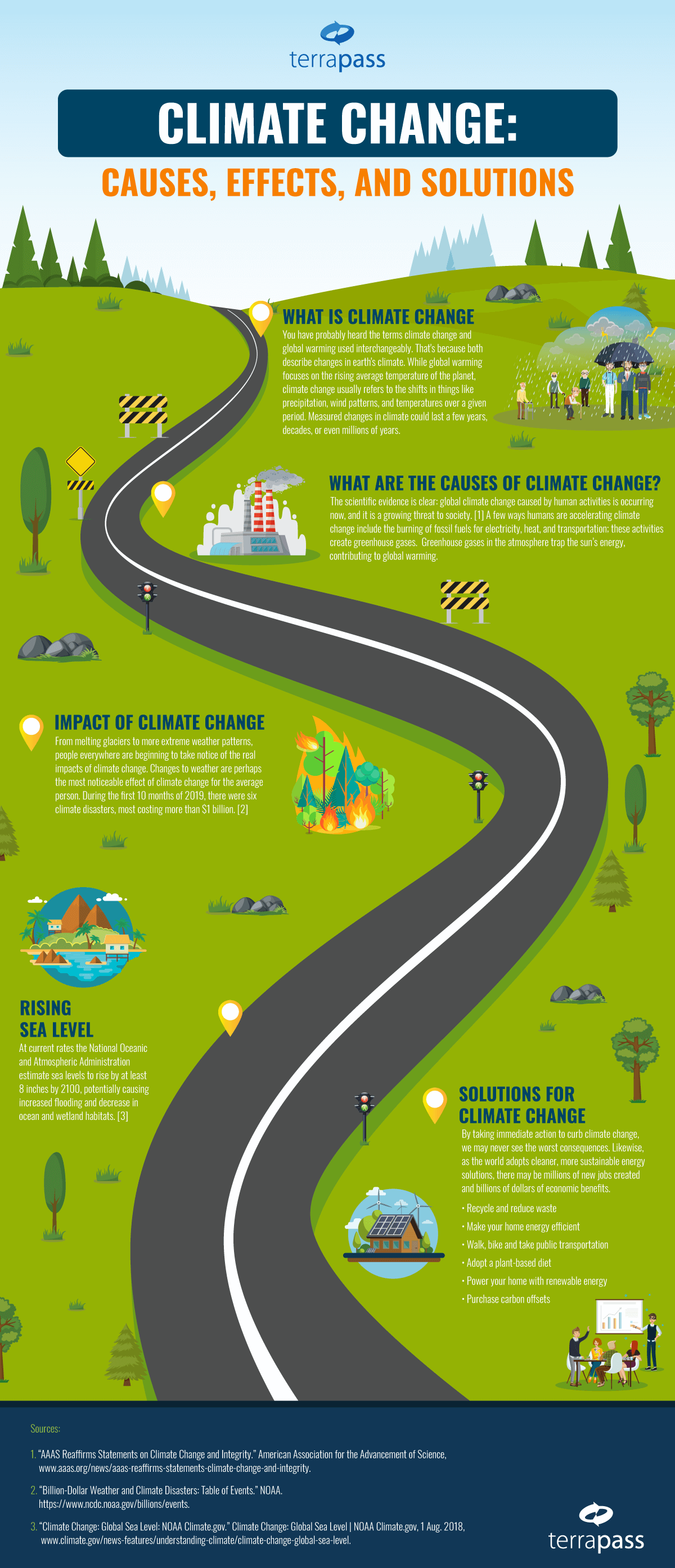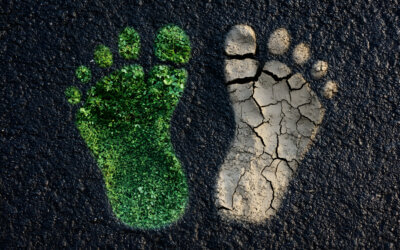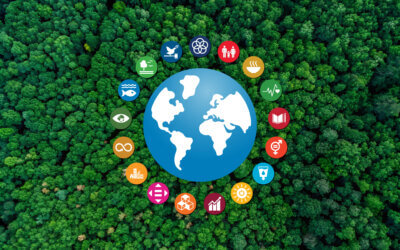Climate change is real, and the evidence is everywhere—from rising sea levels to extreme weather events. While changes in Earth’s climate have occurred naturally over millennia, human activities are now the dominant force behind the current warming trend. Understanding what climate change is, what causes it, and what we can do to stop it is essential for safeguarding our planet and future generations.
What Is Climate Change?
You’ve likely heard the terms “climate change” and “global warming” used interchangeably. However, they have distinct meanings. Global warming refers specifically to the increase in the planet’s average surface temperature, largely due to greenhouse gas emissions. Climate change, on the other hand, encompasses a broader range of long-term changes in temperature, precipitation, wind patterns, and other aspects of the Earth’s climate system.
Climate change has always been part of Earth’s history, driven by natural interactions between five key systems:
-
Atmosphere (air)
-
Biosphere (living things)
-
Cryosphere (ice and permafrost)
-
Hydrosphere (water bodies)
-
Lithosphere (Earth’s crust and upper mantle)
Today, the rapid pace and scale of climate change are primarily driven by human activities.
Climate Change (infographic)
What Are the Causes of Climate Change?
Greenhouse Gases
Greenhouse gases (GHGs) trap heat in the Earth’s atmosphere. While some GHGs occur naturally, human activities have sharply increased their concentrations. Major contributors include:
-
Carbon dioxide (CO2) – Released by burning fossil fuels, deforestation, and land-use changes.
-
Methane (CH4) – Emitted from livestock, landfills, and oil and gas production.
-
Nitrous oxide (N2O) – Produced by agricultural activities and fossil fuel combustion.
-
Chlorofluorocarbons (CFCs) – Man-made chemicals used in refrigeration and aerosols.
CO2 is the most significant and long-lasting of these gases, making it the primary driver of global warming.
While some of these greenhouse gases, such as water vapor, are naturally occurring, others, such as CFCs, are synthetic. CO2 is released into the atmosphere from both natural and human-made causes and is one of the leading contributors to climate change. CO2 has been increasing at an alarming rate and has the potential to stay in the earth’s atmosphere for thousands of years unless it gets absorbed by the ocean, land, trees, and other sources. [4] However, as CO2 production has steadily risen, the earth’s natural resources to absorb it has also been diminished. This is already occurring in many ways as eath’s resources are disappearing from things like deforestation. Some studies even predict that plants and soil will be able to absorb less CO2 as the eath continues to warm—possibly accelerating climate change even further. [5]
Solar Activity
Solar activity, as mentioned above, does play a role in the earth’s climate. While the sun does go through natural cycles, increasing and decreasing the amount of energy that it emits to the earth, it is unlikely that solar activity is a major contributor to global warming or climate change. Since scientists began to measure the sun’s energy hitting our atmosphere, there has not been a measurable upward trend.[6]
Agriculture
There are many significant ways in which agriculture impacts climate change. From deforestation in places like the Amazon to the transportation and livestock that it takes to support agricultural efforts around the world, agriculture is responsible for a significant portion of the world’s greenhouse gas emissions. However, agriculture is also an area that is making tremendous strides to become more sustainable. As productivity increases, less carbon is being emitted to produce more food. Agriculture also has the potential to act as a carbon sink, and could eventually absorb nearly the same amount of CO2 it emits. [7]
Deforestation
Deforestation and climate change often go hand in hand. Not only does climate change increase deforestation by way of wildfires and other extreme weather, but deforestation is also a major contributor to global warming. According to the Earth Day Network, deforestation is the second leading contributor to global greenhouse gasses. [8] Many people and organizations fighting against climate change point to reducing deforestation as one of, if not the most, important issues that must be addressed to slow or prevent climate change. [9]
Human Activity
According to the Environmental Protection Agency, the most significant contributor to climate change in the United States is the burning of fossil fuels for electricity, heat, and transportation. Of these factors, transportation in the form of cars, trucks, ships, trains, and planes emits the largest percentage of CO2–speeding up global warming and remaining a significant cause of climate change. [10]
Livestock
While interconnected to many of the agricultural and deforestation issues we have already touched on, livestock in the form of cattle, sheep, pigs, and poultry play a significant role in climate change. According to one study, “Livestock and Climate Change,” livestock around the world is responsible for 51% of annual global greenhouse gas emissions. [11]
Immediate Effects of Climate Change
From melting glaciers to more extreme weather patterns, people everywhere are beginning to take notice of the real impacts of climate change. While some nations around the world are taking action with initiatives such as the Paris Climate Agreement, others are continuing business as usual–pumping millions of tons of carbon into the atmosphere year after year. While the long-term consequences are still to be seen, for now, climate change continues to cause extreme weather as well as safety and economic challenges on a global scale.
Extreme Weather
Changes to weather are perhaps the most noticeable effect of climate change for the average person. One reason for this is the financial impact severe weather events can have. So far in the U.S. during 2019, there have been six climate disasters, most costing more than $1 billion. [12] According to the National Climate Assessment, extreme weather events will continue to increase in frequency and intensity as climate change continues to happen. [13] Extreme weather influenced by climate change includes:
- Stronger storms & hurricanes
- Heatwaves
- Wildfires
- More flooding
- Heavier droughts
Safety & Economic Challenges
In 2014 the U.S. Department of Defense released a report that stated climate change posed a severe and immediate threat to national security. According to former Secretary of Defense, Chuck Hagel, “Rising global temperatures, changing precipitation patterns, climbing sea levels, and more extreme weather events will intensify the challenges of global instability, hunger, poverty, and conflict.” [14]
Furthermore, climate change is likely to cause economic challenges in many parts of the world. Some estimates have the U.S. already spending around $240 billion annually due to human-caused climate change, and future costs are projected to be even higher. [15] However, putting an exact number on the real costs of climate change is difficult once you consider the staggering costs of losing natural resources like clean air and water.
Long Term Impact of Climate Change
The long term impact of climate change could be absolutely devastating to the planet and everyone and everything living on it. If the world continues on its current trajectory, then we will likely continue to see increasing effects on everyday life.
Health
There are many ways in which climate change could impact people’s health. Depending on age, location, and economic status, climate change is already affecting the health of many and has the potential to impact millions more. According to the Center for Disease Control and Prevention, climate change-related health risks may include: [16]
- Heat-related illness
- Injuries and fatalities from severe weather
- Asthma & cardiovascular disease from air pollution
- Respiratory problems from increased allergens
- Diseases from poor water quality
- Water & food supply insecurities
Negative Impact in Ecosystems
Ecosystems are interconnected webs of living organisms that help support all kinds of plant and biological life. Climate change is already changing seasonal weather patterns and disrupting food distribution for plants and animals throughout the world, potentially causing mass extinction events. Some studies estimate that nearly 30% of plant and animal species are at risk of extinction if global temperatures continue to rise. [17]
Water & Food Resources
Climate change could have a significant impact on food and water supplies. Severe weather and increased temperatures will continue to limit crop productivity and increase the demand for water. With food demand expected to increase by nearly 70% by 2050, the problem will likely only get worse. [18]
Sea Levels Rising
Rising sea levels could have far-reaching effects on coastal cities and habitats. Increasing ocean temperatures and melting ice sheets have steadily contributed to the rise of sea levels on a global scale. At current rates the National Oceanic and Atmospheric Administration estimate sea levels to rise by at least 8 inches by 2100, potentially causing increased flooding and decrease in ocean and wetland habitats. [19]
Shrinking Ice Sheets
While contributing to rising sea levels, shrinking ice sheets present their own set of unique problems, including increased global temperatures and greenhouse gas emissions. Climate change has driven summer melt of the ice sheets covering Greenland and Antarctica to increase by nearly 30% since 1979. [20]
Ocean Acidification
The ocean is one of the main ways in which CO2 gets absorbed. While at first glance that may sound like a net positive, the increasingly human-caused CO2 is pushing the world’s oceans to their limits and causing increased acidity. As pH levels in the ocean decrease, shellfish have difficulty reproducing, and much of the oceans’ food cycle becomes disrupted. [21]
Solutions for Climate Change
While the effects of climate change can seem bleak, there is still hope. By taking immediate action to curb climate change, we may never see the worst consequences. Likewise, as the world adopts cleaner, more sustainable energy solutions, there may be millions of new jobs created and billions of dollars of economic benefits. Below are some practical ways you can battle climate change, including:
-
Switching to renewable energy (solar, wind, hydro)
-
Purchasing Renewable Energy Certificates (RECs) for your home
-
Using energy-efficient appliances and insulating buildings
-
Offsetting your carbon emissions through verified programs
-
Adopting plant-based diets and reducing meat consumption
-
Minimizing food waste and single-use plastics
-
Protecting and restoring forests and wetlands
-
Supporting clean transportation options (EVs, public transit, biking)
Try the Terrapass Flight Carbon Calculator
Traveling by plane? Use the Terrapass Flight Carbon Calculator to estimate your flight emissions and support verified offset projects.
Why Climate Change Matters to Everyone
Climate change isn’t just an environmental problem—it’s an everything problem. It touches every aspect of our lives:
-
Jobs and the economy: Clean energy sectors are rapidly expanding and could create millions of new jobs worldwide.
-
National security: Climate change exacerbates global instability, resource conflicts, and forced migration.
-
Public health: Clean air, safe drinking water, and stable food systems are all at risk.
-
Justice and equity: Low-income communities and developing nations are often hit hardest despite contributing the least to global emissions.
-
Future generations: The choices we make today will shape the legacy we leave behind.
By investing in climate solutions now, we not only avoid catastrophe but also unlock opportunities for innovation, resilience, and shared prosperity.
Brought to you by Terrapass — your trusted partner in carbon offsets and climate education.
Sources:
- Rose, Brian E. “ATM 623: Climate Modeling.” Lecture04 — Climate System Components, www.atmos.albany.edu/facstaff/brose/classes/ATM623_Spring2015/Notes/Lectures/Lecture04%20–%20Climate%20system%20components.html.
- “AAAS Reaffirms Statements on Climate Change and Integrity.” American Association for the Advancement of Science, www.aaas.org/news/aaas-reaffirms-statements-climate-change-and-integrity.
- “The Causes of Climate Change.” NASA, NASA, 6 Sept. 2019, climate.nasa.gov/causes/.
- “The Carbon Cycle.” NASA, earthobservatory.nasa.gov/features/CarbonCycle/page5.php.
- Green, Julia K., et al. “Large Influence of Soil Moisture on Long-Term Terrestrial Carbon Uptake.” Nature, vol. 565, no. 7740, 2019, pp. 476–479., doi:10.1038/s41586-018-0848-x. https://www.nature.com/articles/s41586-018-0848-x.
- “Is the Sun Causing Global Warming? – Climate Change: Vital Signs of the Planet.” NASA, NASA, climate.nasa.gov/faq/14/is-the-sun-causing-global-warming/
- “Agriculture and Greenhouse Gas Emissions.” American Farm Bureau Federation – The Voice of Agriculture, www.fb.org/market-intel/agriculture-and-greenhouse-gas-emissions.
- “Deforestation and Climate Change.” Earth Day Network, www.earthday.org/campaigns/reforestation/deforestation-climate-change/.
- “REDD: Protecting Climate, Forests and Livelihoods.” International Institute for Environment and Development, 24 Jan. 2018, www.iied.org/redd-protecting-climate-forests-livelihoods.
- “Sources of Greenhouse Gas Emissions.” EPA, Environmental Protection Agency, 13 Sept. 2019, www.epa.gov/ghgemissions/sources-greenhouse-gas-emissions.
- Goodland, Robert and Anhang, Jeff. “Livestock and Climate Change” https://www.worldwatch.org/files/pdf/Livestock%20and%20Climate%20Change.pdf.
- “Billion-Dollar Weather and Climate Disasters: Table of Events.” NOAA. https://www.ncdc.noaa.gov/billions/events.
- “Extreme Weather and Climate Change.” Center for Climate and Energy Solutions, 14 Aug. 2019, www.c2es.org/content/extreme-weather-and-climate-change/.
- “DoD Releases 2014 Climate Change Adaptation Roadmap.” U.S. DEPARTMENT OF DEFENSE, www.defense.gov/Newsroom/Releases/Release/Article/605221/.
- “The Economic Case for Climate Action in the United States.” FEUUS, feu-us.org/case-for-climate-action-us/.
- “Climate Change and Public Health – Climate Effects on Health | CDC.” Centers for Disease Control and Prevention, Centers for Disease Control and Prevention, https://www.cdc.gov/climate-health/php/effects/index.html.
- “Climate Impacts on Ecosystems.” EPA, Environmental Protection Agency, 22 Dec. 2016, 19january2017snapshot.epa.gov/climate-impacts/climate-impacts-ecosystems_.html.
- Kijne, Jacob W. “Hugh Turral, Jacob Burke and Jean-Marc Faurès: Climate Change, Water and Food Security.” https://www.fao.org/3/i2096e/i2096e.pdf
- “Climate Change: Global Sea Level: NOAA Climate.gov.” Climate Change: Global Sea Level | NOAA Climate.gov, 1 Aug. 2018, www.climate.gov/news-features/understanding-climate/climate-change-global-sea-level.
- “National Snow and Ice Data Center.” Quick Facts on Ice Sheets | National Snow and Ice Data Center, nsidc.org/cryosphere/quickfacts/icesheets.html.









